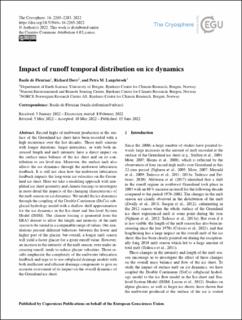| dc.contributor.author | Fleurian, Basile de | |
| dc.contributor.author | Davy, Richard | |
| dc.contributor.author | Langebroek, Petra | |
| dc.date.accessioned | 2022-06-20T11:29:01Z | |
| dc.date.available | 2022-06-20T11:29:01Z | |
| dc.date.created | 2022-06-15T10:16:53Z | |
| dc.date.issued | 2022 | |
| dc.identifier.issn | 1994-0416 | |
| dc.identifier.uri | https://hdl.handle.net/11250/2999593 | |
| dc.description.abstract | Record highs of meltwater production at the surface of the Greenland ice sheet have been recorded with a high recurrence over the last decades. Those melt seasons with longer durations, larger intensities, or with both increased length and melt intensity have a direct impact on the surface mass balance of the ice sheet and on its contribution to sea level rise. Moreover, the surface melt also affects the ice dynamics through the meltwater lubrication feedback. It is still not clear how the meltwater lubrication feedback impacts the long-term ice velocities on the Greenland ice sheet. Here we take a modeling approach with simplified ice sheet geometry and climate forcings to investigate in more detail the impacts of the changing characteristics of the melt season on ice dynamics. We model the ice dynamics through the coupling of the Double Continuum (DoCo) subglacial hydrology model with a shallow shelf approximation for the ice dynamics in the Ice-sheet and Sea-level System Model (ISSM). The climate forcing is generated from the ERA5 dataset to allow the length and intensity of the melt season to be varied in a comparable range of values. Our simulations present different behaviors between the lower and higher part of the glacier, but overall, a longer melt season will yield a faster glacier for a given runoff value. However, an increase in the intensity of the melt season, even under increasing runoff, tends to reduce glacier velocities. Those results emphasize the complexity of the meltwater lubrication feedback and urge us to use subglacial drainage models with both inefficient and efficient drainage components to give an accurate assessment of its impact on the overall dynamics of the Greenland ice sheet. | en_US |
| dc.language.iso | eng | en_US |
| dc.publisher | Copernicus Publications | en_US |
| dc.rights | Navngivelse 4.0 Internasjonal | * |
| dc.rights.uri | http://creativecommons.org/licenses/by/4.0/deed.no | * |
| dc.title | Impact of runoff temporal distribution on ice dynamics | en_US |
| dc.type | Journal article | en_US |
| dc.type | Peer reviewed | en_US |
| dc.description.version | publishedVersion | en_US |
| dc.rights.holder | Copyright 2022 The Author(s) | en_US |
| cristin.ispublished | true | |
| cristin.fulltext | original | |
| cristin.qualitycode | 2 | |
| dc.identifier.doi | 10.5194/tc-16-2265-2022 | |
| dc.identifier.cristin | 2031964 | |
| dc.source.journal | The Cryosphere | en_US |
| dc.source.pagenumber | 2265-2283 | en_US |
| dc.identifier.citation | The Cryosphere. 2022, 16, 2265-2283. | en_US |
| dc.source.volume | 16 | en_US |

